Diplomatic Bluebook 2024
Chapter 2
Resilient and Unwavering Regional Diplomacy
2 United States
(1) Situation in the U.S.
A Politics
In U.S. domestic politics in 2023, attention was focused on the moves of the Republican Party, which became the controlling party in the House of Representatives as a result of the midterm elections in November of the previous year, and how the Biden administration would manage policies in this divided situation in which a party other than the president's party is the majority party in Congress (House of Representatives). With the presidential election approaching in November 2024, attention was also focused on election-related developments, particularly between former President Donald Trump, who had already announced his candidacy in November of the previous year, and President Biden, who announced in April that he would seek a second term.
The 118th Congress was inaugurated on January 3, with the Democrats in control of the Senate and the Republicans in control of the House of Representatives. However, what Congress immediately faced when the session began was not standoff between the Democrats and Republicans, but a fierce confrontation that continues to this day between the mainstream faction, including the party leadership, and hardline conservatives within the House Republicans. With the inauguration of the 118th Congress, Representative Kevin McCarthy, who had served as House Minority Leader in the 117th Congress, was nominated by House Republicans for Speaker, but the conservative hard-liners in the party strongly opposed his selection. In negotiations with the opposition, Mr. McCarthy agreed to relax the procedural requirements for removal of the Speaker and to not raise the debt ceiling without spending cuts, and was eventually elected Speaker of the House after 15 rounds of voting. Speaker McCarthy then agreed with the Biden administration to raise the debt ceiling in June and to pass a stopgap budget in September, but on October 3, hardline Republican conservatives strongly opposed these measures and he was removed from office with the support of Democrats who were discontent with the way he was running Congress. This was the first time in U.S. history that the Speaker of the House was removed from office, and it was precisely McCarthy's concessions to the conservative hard-liners in his party in exchange for his election as Speaker that made it possible. After his dismissal, House Republicans immediately began the process of selecting a new Speaker, and although three prominent Republican members of the House ran for the post one after another, none of them was elected due to severe internal party conflicts. Three weeks later, on October 24, the fourth candidate, Representative Mike Johnson, was finally elected Speaker. The selection of Johnson as the new Speaker of the House was premised on the agreement that had been reached between the former Speaker McCarthy and hardline conservative factions within the Republican Party when the former Speaker was selected. As a result, the new Speaker Johnson, like his predecessor, is vulnerable to pressure from hardline conservative forces within the party and will be expected to run Congress in a way that would reflect their wishes.
With the Republicans in control of the House of Representatives, the Biden administration would need to reach an agreement with the House Republican leadership in order to pass the budget necessary to maintain executive functions. In response, in February, in his State of the Union address, President Biden appealed for bipartisan cooperation and unity to realize policy on issues such as raising the debt ceiling, but at the same time, that appeal meant that President Biden would have to make concessions and compromises through negotiations with the House Republican leadership. In June, the Biden administration reached an agreement with House Republicans to raise the debt ceiling through January 1, 2025, subject to acceptance of House Republican demands, including an increase in federal safety net program eligibility requirements and partial cuts to the Internal Revenue Service budget. As for the stopgap budgets passed in September and November, as a result of compromise, spending was maintained at fiscal 2023 levels, which would actually be negative when inflation is taken into account. The House Republican leadership worked with the Biden administration on these budget measures, but because of the high level of defections among their members, passage of the bills in the House required the approval of a larger number of Democrats than would otherwise have been the case. The hardline conservative wing of the House Republican Party also vehemently opposed this cooperation by the party leadership with the Biden administration and the Democrats. In October, the Biden administration sought to accommodate House Republicans' growing reluctance to support Ukraine by requesting a 106 billion U.S. dollar budget from Congress that would package support for Ukraine, Israel, and Taiwan with enhanced spending on southern border measures, which the House Republicans prioritized. Negotiations then continued among a small number of bipartisan senators, focusing on the content of the border security measures, with the aim of passing a package bill.
In addition, the Supreme Court, which is one of the separate arms of government authority, has had a majority of justices considered conservative since 2020, but the Biden administration is countering the court's conservative decisions with administrative measures. In June, the U.S. Supreme Court ruled in succession that affirmative action in college admissions and partial forgiveness of college tuition loans were unconstitutional. These decisions are not only in direct conflict with the Biden administration's emphasis on diversity and strengthening the middle class, but also undermine the interests of young adults with college and higher degrees and younger generations, who constitute an important part of the Democratic Party's base of support. The Biden administration immediately issued a joint Department of Justice and Department of Education letter to the universities regarding the former, requesting that they continue to work to expand educational opportunities and ensure diversity. With regard to the latter, the Biden administration issued a federal Student Loan Debt Relief Plan in July, a Saving on a Valuable Education (SAVE) plan in August, and an additional Student Loan Debt Relief Plan in October.
While challenging the conservative ruling of the U.S. Supreme Court, the Biden administration, the Democratic Party, and its supporters have made the June 2022 U.S. Supreme Court ruling that the U.S. Constitution does not guarantee the right to abortion (Dobbs v. Jackson Women's Health Organization) a political issue since that year's midterm elections and are actively using it to mobilize their support base for the election. In November, Democrats won the Ohio referendum to enshrine abortion rights in the state constitution (winning a majority), the Virginia House of Delegates elections (majority in both the House and Senate), and the Kentucky gubernatorial election (reelecting Governor Andy Beshear) by making the issue of abortion a key issue. These elections were positioned by both Democrats and Republicans as a prelude to the 2024 presidential and congressional elections, and it remains to be seen whether the abortion issue can continue to be a viable issue for President Biden and the Democratic Party to gain support.
For the 2024 presidential election, by the end of December 2023, the main candidates were President Biden from the Democratic Party; former President Trump, Florida Governor Ron DeSantis, former UN Ambassador Nikki Haley, Mr. Vivek Ramaswamy (a businessman), and former New Jersey Governor Chris Christie from the Republican Party; Mr. Robert F. Kennedy Jr. (son of former Attorney General Robert F. Kennedy) and Dr. Cornel West (a former Harvard University professor) running as independents; and Dr. Jill Stein from the Green Party. After announcing that he would seek re-election, President Biden called his economic policy, which centers on raising taxes on the wealthy, controlling drug prices, and investing in the environment, “Bidenomics,” and in September he became the first president to visit a picket site where the United Auto Workers of America were on strike, in an attempt to demonstrate his focus on the middle class as president. Meanwhile, the Republican Party held presidential candidate debates in August, September, November, and December, but former President Trump did not participate in a single debate, holding rallies with supporters and delivering his own interviews during the same time.
Former President Trump has been indicted on four counts totaling 91 charges and is required to stand trial. In April, a New York state district court indicted the former president over hush money payments to a woman with whom he allegedly had an extramarital affair. In June, a federal judge indicted him on charges related to the illegal hiding of classified documents at Trump's home. In August, separate indictments were filed in federal court and a Georgia district court relating to attempts to overturn the results of the 2020 presidential election. These trials are expected to take place at the same time as the presidential primaries in 2024, and attention is focused on the impact the trials will have on former President Trump's approval rating, election campaign, and campaign finances.
In addition, cases against former President Trump are based on Section 3 of the 14th Amendment to the U.S. Constitution, which prohibits a federal or state official, who has made an oath to uphold the Constitution, from holding office if they join in an insurrection or rebellion against the state. The merits of the case and the factual findings regarding former President Trump's complicity in the insurrection are under dispute in more than 20 states.
B Economy
(A)Current Economic Situation
While the U.S. economy continued to be vulnerable to risks of a recession due to monetary tightening, a recession was averted thanks to strong consumer spending and other factors. Real GDP grew at 1.9% year-on-year compared to all of 2022, and continued to grow at a more positive rate in 2023, reaching 4.9% year-on-year from July to September, the highest growth rate since October 2021. Consumer spending, which accounts for 70% of GDP, led GDP growth at a rate of 4.0% year-on-year. Going forward, the impact of tighter monetary policy to date may pose a challenge to the slowdown in personal consumption due to lower labor demand.
As for inflation, which had been the focus of public attention, the consumer price index (CPI) slowed after reaching 9% year-on-year in September 2022 for the first time in about 40 years and has remained at the 3% level since June 2023. Regarding tighter monetary policy, which was initiated to normalize high inflation, the Federal Open Market Committee (FOMC) raised federal funds rates at its July meeting and has since kept its target rate range between 5.25% to 5.50%.
With employment, the unemployment rate remained steady in 2023 at the 3% level throughout the year, and the number of workers employed increased steadily. The rate of increase in average hourly earnings also trended downward in line with the decline in the inflation rate. Meanwhile, the labor participation rate (the ratio of the labor force (employed and unemployed) to the working-age population (population aged 16 and over)) stood at 62.5% (as of December 2023), and was on an improving trend, but is still in the process of recovery compared to 63.4% (as of February 2020) before the COVID-19 pandemic. The tight labor supply and demand is a factor that will lead to continued tighter monetary policy.
(B)Major economic policies
In June, the U.S. government summarized its economic policy since the start of the administration as “Bidenomics,” which consists of three key pillars: (1) Making smart public investments, (2) Empowering and educating workers, and (3) Promoting competition to lower costs and help small businesses thrive. The government also highlighted the creation of more than 13 million jobs, including about 800,000 jobs in the manufacturing sector, and more than 10 million applications for start-ups in the two years of 2021 and 2022 as achievements. In particular, the Biden administration recognized that targeted public investment in sectors aimed at ensuring long-term economic and security interests, such as infrastructure, semiconductors, clean energy, and climate security, will attract private investment. Based on this recognition, the administration pointed out that the bipartisan Infrastructure Investment and Jobs Act, which was enacted in November 2021 as part of the American Jobs Plan and includes mandating the use of U.S.-made building materials, the CHIPS and Science Act, which was enacted in August 2022, and the Inflation Reduction Act, which was enacted as part of the American Families Plan and included tax deduction measures for the introduction of clean energy and the purchase of electric vehicles, have encouraged approximately 490 billion U.S. dollars in private investment, including future projections, and that manufacturing and construction spending has nearly doubled in two years, with 300,000 new jobs created in the clean energy sector in 2022 alone.
Prior to this announcement, in April, Assistant to the President for National Security Affairs, Jake Sullivan, delivered a speech in which he expressed the idea of promoting a “new Washington consensus” consisting of a new industrial strategy in key strategic sectors, resilient supply chains among like-minded countries, promotion of innovative trade agreements focused on labor and environmental protection, transparent and inclusive development assistance, and de-risking (risk reduction) with China, to address the challenges posed by past economic policies, including oversimplified market efficiency, economic integration with non-market economies, the accelerating climate crisis, and economic inequality.
(2) Japan-U.S. Political Relations
Under the deep trust between the leaders and foreign ministers, the Japan-U.S. Alliance is stronger than ever, and the two countries are working closely together not only on security and the economy, but also on various issues facing the international community, including the situation in the Middle East and regional situations such as China, North Korea, and Ukraine.
On January 11, Foreign Minister Hayashi, who visited Washington, D.C. to attend the Japan-U.S. Security Consultative Committee (Japan-U.S. “2+2”), held a foreign ministers' meeting with Secretary of State Antony Blinken. The two foreign ministers, building upon the discussions held at the Japan-U.S. “2+2” before this meeting, reaffirmed their commitment to further strengthen the deterrence and response capabilities of the Japan-U.S. Alliance as a whole by linking the reinforcement of Japan's defense capabilities to making the capabilities of the U.S. more effective. The two ministers concurred to continue to work closely together in addressing issues related to China and for the success of the G7 Hiroshima Summit and the G7 Foreign Ministers' Meeting.
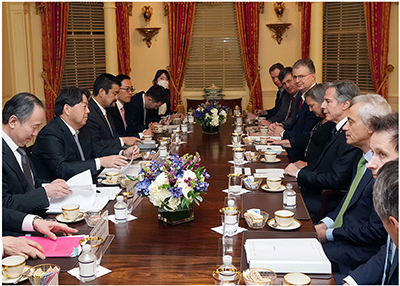 Japan-U.S. Foreign Ministers' Meeting (January 11, Washington, D.C., U.S.)
Japan-U.S. Foreign Ministers' Meeting (January 11, Washington, D.C., U.S.)On January 13, Prime Minister Kishida, who was visiting Washington, D.C., held a Japan-U.S. Summit Meeting with President Biden.
The two leaders welcomed that the national security strategies of the two countries announced in 2022 are aligned with each other, as both countries face the most severe and complex security environment in recent years and renewed their determination to further strengthen the deterrence and response capabilities of the Japan-U.S. Alliance, including seeking to create synergies in implementation of the strategies of the two countries. The two leaders then instructed further deepening of concrete consultations regarding Japan-U.S. cooperation on the security front. The two leaders exchanged views on the regional issues, and concurred that Japan and the U.S. would continue to work closely together in dealing with various issues concerning China and that they would cooperate with China on shared challenges, while also reiterating the importance of peace and stability across the Taiwan Strait and encouraging the peaceful resolution of the cross-Strait issue. Furthermore, they concurred on continuing to work closely together between Japan and the U.S. as well as among Japan, the U.S., and the ROK toward the complete denuclearization of North Korea. Prime Minister Kishida also asked for continued understanding and cooperation of the U.S. for the immediate resolution of the abductions issue. Regarding Russia's aggression against Ukraine, the two leaders concurred on continuing to strongly promote sanctions against Russia and support for Ukraine in close coordination with the G7 and other like-minded countries. They also reaffirmed their views that Russia's nuclear threat is absolutely unacceptable, and Russia should never use nuclear weapons under any circumstances. At the G7 Hiroshima Summit, Prime Minister Kishida explained that he would like to demonstrate the G7's vision and determination to uphold the international order based on the rule of law and also discuss the Indo-Pacific substantially. The two leaders then concurred on working together toward a world without nuclear weapons, and shared the view that it is important for the G7 to work in solidarity in such areas as the global economy, including energy and food security, economic security, and global issues such as climate change, health and development. The leaders reaffirmed their commitment that Japan and the U.S. will work closely together toward the success of the G7 Hiroshima Summit. The two leaders also exchanged views on the field of economy, and concurred that Japan and the U.S. will lead the international community toward sustainable and inclusive economic growth and maintaining and strengthening a rules-based, free and fair international economic order. The two leaders shared the view that U.S. engagement in the regional economic order is becoming increasingly important, and concurred on cooperating for the progress of Indo-Pacific Economic Framework for Prosperity (IPEF) negotiations. Prime Minister Kishida conveyed Japan's position on the Trans-Pacific Partnership (TPP), from a strategic perspective. The two leaders also concurred on promoting “Data Free Flow with Trust (DFFT).” The two leaders concurred on strengthening supply chain resilience among like-minded countries to handle economic security challenges, including economic coercion. They also confirmed their commitment to cooperate to promote and protect critical technologies, including semiconductors as well as biotechnology, quantum and AI technologies. Furthermore, the two leaders shared views on the importance of working toward strengthening energy security. The two leaders concurred on further promoting Japan-U.S. cooperation in the area of outer space. Furthermore, Prime Minister Kishida stated that he will strengthen efforts to realize FOIP, to which President Biden reiterated the unwavering U.S. commitment to the region. The two leaders concurred that Japan and the U.S. will continue to promote endeavors to realize FOIP. The two leaders reconfirmed unprecedented Japan-U.S. cooperation, rooted in the shared vision of a free and open Indo-Pacific and a peaceful and prosperous world, and guided by the shared values and principles including the rule of law, and issued the Joint Statement of the U.S. and Japan.
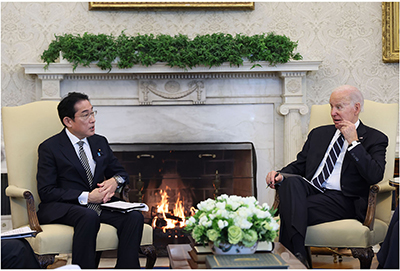 Japan-U.S. Summit Meeting (January 13, Washington, D.C., U.S.; Photo: Cabinet Public Affairs Office)
Japan-U.S. Summit Meeting (January 13, Washington, D.C., U.S.; Photo: Cabinet Public Affairs Office)On March 3, Foreign Minister Hayashi, who was visiting New Delhi, India to attend the Japan-Australia-India-U.S. (Quad) Foreign Ministers' Meeting, met with Secretary of State Blinken and held a Japan-U.S. foreign ministers' meeting. The two ministers confirmed that Japan and the U.S. will remain united and continue to drive efforts toward the realization of FOIP by leveraging cooperation of the G7 and Japan, U.S., Australia, and India. The two ministers concurred that, as one year has passed since the start of Russia's aggression against Ukraine, they will continue to impose severe sanctions against Russia and provide strong support for Ukraine. They also exchanged views on issues related to China.
On April 17, Foreign Minister Hayashi held a foreign ministers' meeting with Secretary of State Blinken, who was visiting Japan to attend the G7 Foreign Ministers' Meeting. The two foreign ministers concurred to cooperate to further strengthen the deterrence and response capabilities of the Japan-U.S. Alliance, and, building upon the discussions at the G7 Foreign Ministers' Meeting, they held a frank exchange of views on the situation in Ukraine, responses to issues relating to China, responses to North Korea including the abductions issue, and the importance of engagement and support for the so-called “Global South.” The two foreign ministers also exchanged views on the IPEF and the TPP.
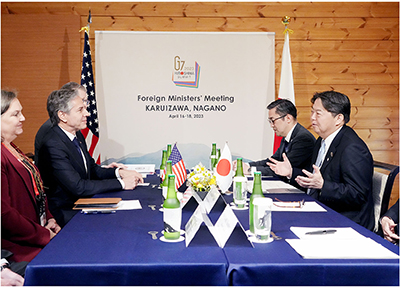 Japan-U.S. Foreign Ministers' Meeting (April 17, Tokyo)
Japan-U.S. Foreign Ministers' Meeting (April 17, Tokyo)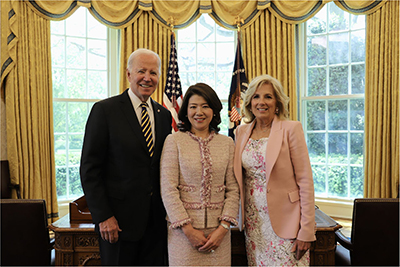 Meeting with President Biden (April 17, Washington, D.C., U.S.)
Meeting with President Biden (April 17, Washington, D.C., U.S.)In April, Mrs. KISHIDA Yuko, the spouse of Prime Minister Kishida, visited the White House at the invitation of Dr. Jill Biden, the First Lady of the United States (U.S.). This was the first time that the spouse of the Prime Minister of Japan made a solo visit to the U.S. at the invitation of the First Lady of the U.S. It demonstrates the unprecedented close and firm ties between Japan and the U.S.
On this occasion that was the first of its kind, Mrs. Kishida's goal was to deepen her personal relationship of trust with First Lady Dr. Biden, thereby contributing to even closer Japan-U.S. relations. It is very important that the two spouses spend time together and build a personal relationship to further strengthen the relationship between the leaders of the two countries as well as to further strengthen Japan-U.S. relations.
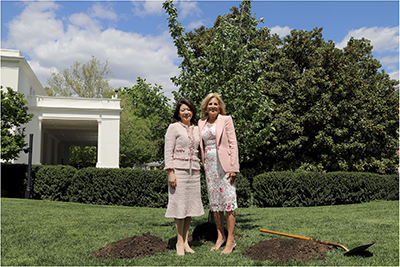 Mrs. Kishida and First Lady Dr. Biden planting a cherry tree (April 17, Washington, D.C., U.S.)
Mrs. Kishida and First Lady Dr. Biden planting a cherry tree (April 17, Washington, D.C., U.S.)When Mrs. Kishida arrived at the White House and was greeted by First Lady Dr. Biden, she immediately realized that First Lady Dr. Biden shared exactly the same sentiments as she did. One of the key phrases during Mrs. Kishida's visit was “cherry blossoms,” as it was during the National Cherry Blossom Festival, Sakura Matsuri1 – Japanese Street Festival,2 which is held annually in Washington, D.C. during the flowering season of Somei Yoshino cherry trees, which were presented by Japan in 1912. For this reason, Mrs. Kishida chose to wear cherry blossom-colored attire, and First Lady Dr. Biden coordinated her clothing in the same color scheme. The sight of the two of them standing side by side symbolized the harmonious sentiments of Japan and the U.S.
Prior to the luncheon, Mrs. Kishida made matcha for First Lady Dr. Biden in a cherry blossom patterned tea bowl that she had brought from Japan. Appreciating the idea of “Ichigo-Ichie,” which means to treasure each encounter, they shared the recognition that the current relationship between Japan and the U.S. is in a splendid state today.
The luncheon was held in a relaxed atmosphere around a table decorated with a cherry blossom cloth. Afterwards, First Lady Dr. Biden gave a tour of the White House, which was lit up in cherry blossom colors, while live music was performed, including Japanese songs such as “Furusato” (Hometown). On the way, they stopped by the Oval Office, where Mrs. Kishida met with President Biden. The Oval Office was filled with friendly smiles during the brief conversation with President Biden. To cap off the visit, Mrs. Kishida and First Lady Dr. Biden planted a cherry tree sapling in the White House garden. First Lady Dr. Biden said, “The planting of this tree is a symbol of the friendship between our two nations forever and ever.” They confirmed the broad and deep relationship not only between the governments of Japan and the U.S., but also between the people of each country.
The visit to the White House began with a friendly handshake between Mrs. Kishida and First Lady Dr. Biden. They were considerate of each other during their time together and hugged before parting. Although the visit lasted only a few hours, they built a solid trusting relationship, and the occasion symbolized the further promotion of friendship and goodwill between Japan and the U.S.
- 1 This is the largest event in Washington, D.C., held to commemorate the gift of about 3,000 cherry trees by Tokyo mayor OZAKI Yukio as a token of goodwill between Japan and the U.S. It attracts about 1.5 million visitors, and events related to Japanese and U.S. culture are held for about one month.
- 2 The Japan-America Society of Washington DC holds this Japanese culture Street Festival with a long history as part of the National Cherry Blossom Festival. It marked its 61st anniversary in 2023. During her visit to the U.S., Mrs. Kishida observed the festival, which was bustling with many people.
On May 18, Prime Minister Kishida held a summit meeting with President Biden, who visited Japan to attend the G7 Hiroshima Summit. The two leaders concurred that it is important for Japan and the U.S. to coordinate closely in the field of startup and innovation, including promoting the “Global Startup Campus” initiative in order to create an ecosystem of innovation and startup in the field of deep tech.2 The two leaders also welcomed the finalization of a Memorandum of Cooperation on education and technology. President Biden reiterated the U.S. commitment to the defense of Japan under the Japan-U.S. Treaty of Mutual Cooperation and Security, backed by the full range of capabilities, including nuclear, and, in this context, the two leaders reaffirmed their intent to ensure full bilateral coordination throughout every phase of a developing situation. The two leaders exchanged views on regional developments, including China, the ROK, North Korea, Russia's aggression against Ukraine, and the so-called Global South. They also exchanged views on the IPEF and the CPTPP, and shared the importance of promoting and protecting critical technologies. They welcomed a planned signing of partnerships between universities and companies in Japan and the U.S. in the area of quantum and semiconductors and concurred on expanding cooperation into the areas of biotechnology and AI. Furthermore, both leaders shared the importance of working together toward strengthening energy security, and concurred on further materializing economic security cooperation through the Japan-U.S. Economic Policy Consultative Committee (the Economic “2+2”).
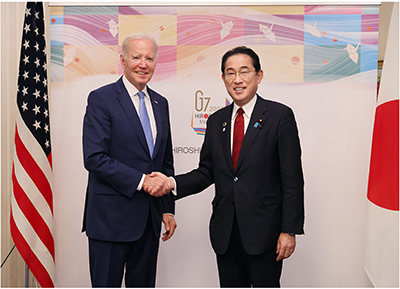 Japan-U.S. Summit Meeting (May 18, Hiroshima Prefecture; Photo: Cabinet Public Affairs Office)
Japan-U.S. Summit Meeting (May 18, Hiroshima Prefecture; Photo: Cabinet Public Affairs Office)The following day, on the 19th, Foreign Minister Hayashi held a Japan-U.S. Foreign Ministers' Meeting with Secretary of State Blinken, who was also visiting Japan. The two ministers concurred to steadily implement cooperation to further strengthen the deterrence and response capabilities of the Japan-U.S. Alliance, and also exchanged views on issues relating to China, as well as regional situations in North Korea, Russia, Ukraine, and elsewhere. They concurred to materialize economic security cooperation in the Economic “2+2,” and exchanged views on the IPEF and CPTPP.
On June 17, Foreign Minister Hayashi had a telephone call with Secretary of State Blinken, who was en route from Washington, D.C. to Beijing. Ahead of his own visit to China, Secretary of State Blinken explained the U.S. government's intention regarding the visit, and the two ministers shared the view that Japan and the U.S. would continue to work closely together in addressing issues relating to China. The two ministers strongly condemned North Korea's launch of multiple ballistic missiles that landed within Japan's Exclusive Economic Zone. The two ministers shared the recognition that North Korea's ballistic missile launches with an unprecedented frequency and in an unprecedented manner, constitute a grave and imminent threat to regional security and pose a clear and serious challenge to the international community. The two ministers also reaffirmed the importance of strengthening coordination between Japan and the U.S. as well as among Japan, the U.S., and the ROK.
On August 18, Prime Minister Kishida visited Camp David, U.S., to attend the Japan-U.S.-ROK Summit Meeting and held a Japan-U.S. summit meeting with President Biden. Prime Minister Kishida expressed his sympathies on the damage caused by the wildfires in Maui and stated Japan's decision to provide relief measures for the victims of the disaster. He also stated that the Japan-U.S.-ROK Summit Meeting was meaningful, and in response, President Biden stated that he wished to deepen cooperation between Japan and the U.S. as well as among Japan, the U.S., and the ROK under the increasingly severe security environment. The two leaders exchanged views on regional situations, including Russia's aggression against Ukraine and issues relating to China. Prime Minister Kishida expressed his appreciation for the U.S. support and understanding concerning Japan's efforts on the ALPS treated water.3 The two leaders exchanged views on coordination to prevent the spread of disinformation regarding the ALPS treated water. Furthermore, recognizing the U.S. commitment to the defense of Japan backed by the full range of U.S. capabilities, the two leaders welcomed that the two countries will initiate the joint development of GPI (Glide Phase Interceptor) for further strengthening the deterrence and response capabilities of the Japan-U.S. Alliance.
Foreign Minister Kamikawa, who assumed her new post on September 13, held a telephone call with Secretary of State Blinken on September 14, the day after assuming her new post, as her first telephone call with the U.S. foreign minister. Foreign Minister Kamikawa expressed that she would like to build a good relationship with Secretary Blinken and to further strengthen the Japan-U.S. Alliance, which is stronger than ever. Secretary Blinken offered his congratulations to Foreign Minister Kamikawa for her assumption of office. The two ministers exchanged their views on regional issues and concurred on continuing to work closely together on Russia's aggression against Ukraine, issues related to China, and North Korea's nuclear and missile development and the abductions issue. The two ministers also confirmed that they would continue to cooperate on Japan-U.S. security and Japan-U.S. economic affairs.
On September 18, soon after the telephone call immediately following her inauguration as foreign minister, Foreign Minister Kamikawa, who was visiting New York for the UN General Assembly, held a foreign ministers' meeting with Secretary of State Blinken. The two ministers exchanged views on the many issues facing the international community, including Russia's aggression against Ukraine and issues concerning North Korea and China. Also, Minister Kamikawa stated her appreciation for the U.S. support and understanding to Japan's efforts on the ALPS treated water. The two ministers concurred to continue the discussion for deepening Japan's concrete security cooperation to further strengthen the deterrence and response capabilities of the Japan-U.S. Alliance, and to consult closely at various levels toward strengthening extended deterrence. Minister Kamikawa also stated that she would like to collaborate closely on the field of Women, Peace, and Security (WPS), and Secretary Blinken expressed his support.
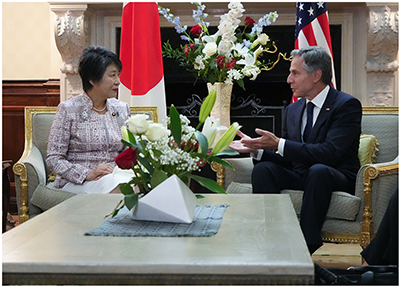 Japan-U.S. Foreign Ministers' Meeting (September 18, New York, U.S.)
Japan-U.S. Foreign Ministers' Meeting (September 18, New York, U.S.)On November 7, Foreign Minister Kamikawa held a foreign ministers' meeting with Secretary of State Blinken, who was visiting Japan to attend the G7 Foreign Ministers' Meeting. Minister Kamikawa unequivocally condemned the terror attack on October 7th by Hamas and others. Minister Kamikawa also stated her utmost support for the U.S. diplomatic efforts on the situation in Israel and Palestine and stated that the firm unity between Japan and the U.S. is important at a time when the international community faces a variety of challenges. The two ministers held a candid exchange of views on the situation in the Middle East. The two ministers concurred on continuing to work closely to improve the humanitarian situation in Gaza and toward realizing humanitarian pauses that would contribute to such ends, as well as to realize a two-state solution. The two ministers further concurred on continuing diplomatic efforts to prevent the current situation from spreading to the Middle East region at large. The two ministers also concurred on continuing to work closely together on issues facing the international community, including Russia's aggression against Ukraine and various issues relating to China.
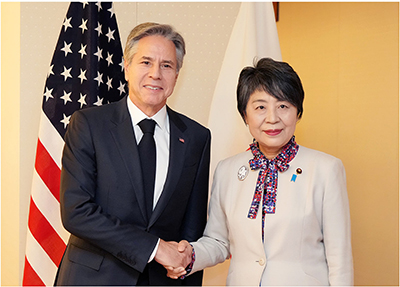 Japan-U.S. Foreign Ministers' Meeting (November 7, Tokyo)
Japan-U.S. Foreign Ministers' Meeting (November 7, Tokyo)On November 16, Prime Minister Kishida, who was visiting San Francisco to attend the APEC Leaders' Meeting, held a summit meeting with President Biden. He welcomed the significant progress of the IPEF and stated that the holding of the Economic “2+2” was timely. The two leaders exchanged views on regional situations, including the situation in the Middle East and Russia's aggression against Ukraine. They concurred to continue close Japan-U.S. cooperation in addressing issues relating to China and confirmed the importance of cooperating with China on issues of common concern, taking into account the results of the U.S.-China Summit held the previous day. Furthermore, during the meeting, President Biden extended an invitation to Prime Minister Kishida to make an official visit in early 2024.
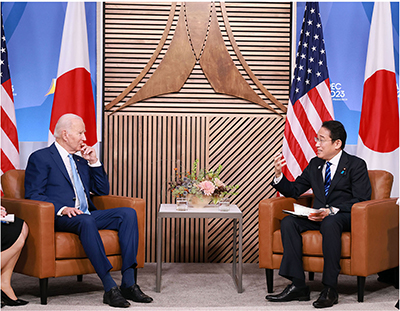 Japan-U.S. Summit Meeting (November 16, San Francisco, U.S.; Photo: Cabinet Public Affairs Office)
Japan-U.S. Summit Meeting (November 16, San Francisco, U.S.; Photo: Cabinet Public Affairs Office)On January 12, 2024, during a visit to Washington, D.C., Foreign Minister Kamikawa met with Secretary of State Blinken for a foreign ministers' meeting. Minister Kamikawa stated that holding a candid discussion at the beginning of the new year, looking ahead to this year and beyond, was meaningful. Minister Kamikawa expressed her appreciation for the cordial messages of sympathy from President Biden and Dr. Jill Biden as well as Secretary Blinken, following the Noto Peninsula Earthquake. The two ministers concurred on coordinating to further strengthen the Japan-U.S. Alliance, a global partnership, to uphold and strengthen the free and open international order based on the rule of law and to ensure the world where the human dignity of each person is respected. The two ministers also concurred on further strengthening the deterrence and response capabilities of the Japan-U.S. Alliance. The two ministers exchanged views on regional situations, including the situation in the Indo-Pacific region, Russia's aggression against Ukraine, and the situation in the Middle East. In addition, Foreign Minister Kamikawa stated that she would like to collaborate closely with the U.S. regarding WPS, including in the UN Security Council, and Secretary Blinken expressed his support.
- 2 A technology based on scientific discoveries obtained through research in a specific field of natural sciences, which, if commercialized and implemented in society, has the potential to have an impact on society, such as by solving socio-economic issues that need to be resolved nationally or globally (technology such as AI and big data, bio-materials, robotics, electronics, sensors and IoT in the fields and sectors of agriculture and food, environment and energy, health, medicine, ocean and space. (Maru and Obara (2019)) (Created based on “White Paper on International Economy and Trade 2023” (Ministry of Economy, Trade and Industry) https://www.meti.go.jp/report/tsuhaku2023/2023honbun/i2250000.html))
- 3 ALPS treated water is water which is processed by devices such as ALPS (Advanced Liquid Processing System) to ensure that the radioactive materials other than tritium surely meet the regulatory standards for safety. ALPS treated water is then sufficiently diluted so that the concentrations of the radioactive materials including tritium is far below the regulatory standards for safety, and then finally discharged into the sea.
(3) Japan-U.S. Economic Relations
Japan-U.S. economic relations are one of the three pillars of the Japan-U.S. Alliance, together with national security and human interactions. For example, Japan has been the world's largest investor in the U.S. for four consecutive years in terms of outstanding direct investment in the U.S. (775.2 billion U.S. dollars in 2022), and helped to create approximately 960,000 jobs in 2021 (second place following the UK). In addition to such multifaceted efforts to strengthen Japan-U.S. bilateral relations through vigorous investment and employment creation, 2023 was a year that saw more active face-to-face diplomacy and deeper Japan-U.S. economic relations.
Japan and the U.S. are strengthening their cooperation in a wide range of fields together with regional partners with the aim of achieving sustainable and inclusive economic growth in the Indo-Pacific region.
Regarding the IPEF (See Chapter 3, Section 3, 2(1) A(B) ), which was launched in conjunction with President Biden's visit to Japan in May 2022, a ministerial-level meeting was held in Detroit in May 2023, and the substantial conclusion of the IPEF Supply Chain Agreement (Pillar 2) was announced. Furthermore, in November that year, summit and ministerial-level meetings were held in San Francisco, where a signing ceremony for the IPEF Supply Chain Agreement was held, and the substantial conclusion of the IPEF Clean Economy Agreement (Pillar 3) and the IPEF Fair Economy Agreement (Pillar 4) was announced. Japan will continue to contribute constructively to IPEF discussions while working closely with regional partner countries in order to achieve sustainable and inclusive economic growth in the Indo-Pacific region.
At the Japan-U.S. Partnership on Trade, which was launched in November 2021, meetings were held in February and December 2023, discussing issues such as strengthening Japan-U.S. cooperation in the field of trade in the Indo-Pacific region and Japan-U.S. cooperation on the global agenda.
During the fifth through seventh expert-level working group meeting of the Japan-U.S. Global Digital Connectivity Partnership (GDCP) held in April, August, and December, government officials and private sectors exchanged views on Open RAN, 5G, and submarine cables, among other issues, and Japan and the U.S. seized various other opportunities to strengthen cooperation in the digital field. In particular, with regard to ICT infrastructure such as Open RAN and 5G, it was confirmed that Japan and the U.S. will identify priority countries to engage with a shared vision and will continue to hold discussions with the aim of expanding cooperation to promote inclusive Internet connectivity and build secure ICT infrastructure.
Facing the prospect of significant increase in demand for electric vehicle batteries, it was an urgent matter to secure critical minerals which are essential to the production of clean vehicles. In light of this situation, Japan aimed to build resilient supply chains through coordination between Japan and the U.S. and also among like-minded countries with strengthened cooperation for ensuring sustainable and equitable supply chains for such critical minerals. Following this, on March 28, the “Agreement between the Government of Japan and the Government of the United States on Strengthening Critical Minerals Supply Chains” (Japan-U.S. Critical Minerals Agreement (CMA)) was signed at the office of the U.S. Trade Representative in Washington, D.C., between Ambassador of Japan to the U.S. Tomita, and U.S. Trade Representative Katherine Tai. Based on the conclusion of this agreement and others, Japan has become a “country with which the United States has a free trade agreement in effect” under the U.S. Inflation Reduction Act, and relevant critical minerals extracted or processed in Japan now qualify for tax credits under the electric vehicle (EV) tax incentive program.
Taking into account the progress of these individual cooperation projects, the Second Ministerial Meeting of the Japan-U.S. Economic Policy Consultative Committee (the Economic “2+2”), which was launched in January 2022, was held in November, where Foreign Minister Kamikawa, Minister of Economy, Trade and Industry NISHIMURA Yasutoshi, Secretary of State Blinken, and Secretary of Commerce Raimondo held strategic discussions on (1) strengthening the rules-based economic order in the Indo-Pacific region, and (2) strengthening economic resilience as well as promoting and protecting critical and emerging technologies, and issued a joint statement. The two sides concurred to continue discussions at the vice-ministerial level and to hold ministerial meetings on a regular basis in order to further expand and deepen Japan-U.S. cooperation in the economic field from a strategic point of view.
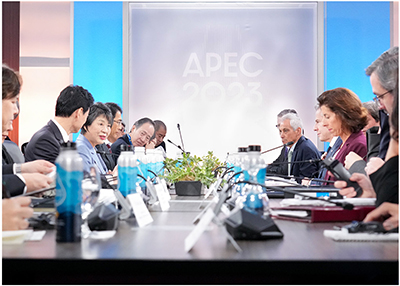 Second Ministerial Meeting of the Japan-U.S. Economic Policy Consultative Committee (the Economic “2+2”)(November 14, San Francisco, U.S.)
Second Ministerial Meeting of the Japan-U.S. Economic Policy Consultative Committee (the Economic “2+2”)(November 14, San Francisco, U.S.)Furthermore, when Foreign Minister Kamikawa visited Washington, D.C., in January 2024, she attended a Japan-U.S. Foreign Ministers' Meeting and exchanged views with Secretary of Commerce Raimondo on future initiatives based on the outcomes of the Economic “2+2” meeting and the IPEF in November.
Along with the federal government, building closer ties with the unique individual states of the U.S. will help deepen Japan-U.S. economic ties at an even closer level. In 2023, the Japan-U.S. Business Conference, the Joint Meeting of the Midwest U.S.-Japan & the Japan-Midwest U.S. Association & Midwest U.S.-Japan Association, and the Joint Meeting of the Japan-U.S. Southeast & Southeast U.S./Japan Associations, and the Japan-U.S. Southeast Association meetings were held in person in Japan, and on these occasions, several U.S. governors led economic and trade missions to Japan. This was followed by individual occasions where the governors of Virginia and New Jersey, among others, visited Japan. The Government of Japan also signed the Memorandum of Cooperation on Economic and Trade Relations with the Government of Florida. Additionally, in April, a memorandum concerning reciprocal partial exemptions of the examination for driver licenses with the state of Colorado was signed. 4
Moreover, in order to strengthen the foundation of Japan-U.S. economic relations from the grassroots level, the Government of Japan is also working as one on efforts to promote understanding of Japan. Since the launch of the Government Taskforce on Strengthening Japan-U.S. Ties at the Grass Roots Tour in 2017, the Government of Japan has undertaken efforts to build tailor-made relations in accordance with the characteristics of each region and the level of interest in Japan within the target regions. As an example, various initiatives have been implemented with the cooperation of various ministries and agencies, such as the “Grassroots Caravan” to disseminate the contributions of Japanese companies to regional economies, and projects related to supporting Japanese start-up companies in light of the “New Form of Capitalism” set forth by the Kishida Cabinet. Going forward, toward further progress in Japan-U.S. economic relations, the basic tenets of “Action Plan 2.0”, an approach in line with the Biden administration's priority policies (emphasis on workers and the middle class, climate change and energy, innovation and science technology, etc.), will continue to be effective guidelines. At the same time, in line with “Action Plan 3.0,” which was formulated in 2023 by adding the perspective of strengthening Japan-U.S. supply chain cooperation to the “Action Plan 2.0,” the Government of Japan will implement various initiatives in an all-Japan manner to further promote understanding with Japan at the grassroots level.
- 4 In order to reduce the burden on local Japanese nationals in obtaining driver's licenses, a memorandum concerning reciprocal partial exemptions of the examination for driver licenses with seven states have already signed: Maryland, Washington, Hawaii, Virginia, Ohio, and Indiana.
Do you know how many sister city and friendship city relationships there are between Japan and Hawaii? There have been as many as 30 relationships of this kind, with long-lasting, active exchanges. Some exchanges were initiated based on hometown associations established in Hawaii by Japanese immigrants and their descendants, while others were initiated by a mutual desire for peace and security after the harsh experience of World War II or tragic maritime accidents. As these examples show, the sister city and friendship city relationships between Japan and Hawaii have a long and deep history of camaraderie that began with the arrival of Japanese immigrants in Hawaii over 150 years ago.
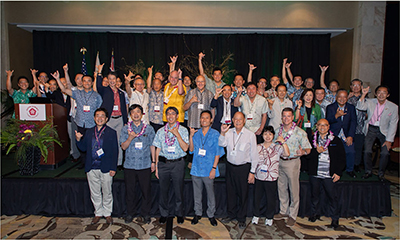 Group photo of the Hawaii-Japan Sister State & Sister City Summit (July 27, Hawaii, U.S.; Photo: JASH)
Group photo of the Hawaii-Japan Sister State & Sister City Summit (July 27, Hawaii, U.S.; Photo: JASH)Although sister city and friendship city exchanges are indispensable parts of the Japan-Hawaii relationship, in-person exchanges were suspended for a while due to the spread of COVID-19. Later, once COVID-19 had subsided in Hawaii, representatives from 22 Japanese local governments with sister city and friendship city relationships with Hawaii gathered in Honolulu on July 27 and 28 for the first “Hawaii-Japan Sister State & Sister City Summit” with the aim of strengthening the bonds that have been established and developing new ties. A cumulative total of 400 people attended the Summit, including the governors of six prefectures and mayors and their representatives of 16 cities and towns from Japan, as well as the Governor of Hawaii and the Mayors of Honolulu, Kauai, Maui, and Hawaii from the State of Hawaii. The local leaders of Japan and Hawaii met in-person for the first time in a long while. They discussed the possibility of expanding the sister city and friendship city exchanges that have been conducted on a one-on-one basis in the past, and exploring multilayered cooperation between relevant cities to make the exchanges more effective in the future. Additionally, panel discussions were held inviting leaders in the fields of sustainable energy, education, sustainable tourism, as well as business and economy, which are common issues to Japan and Hawaii.
 Ainu dance of Hokkaido performed at the commemorative reception at the Consul General's official residence (July 27, Hawaii, U.S.)
Ainu dance of Hokkaido performed at the commemorative reception at the Consul General's official residence (July 27, Hawaii, U.S.)The Consulate General of Japan in Honolulu cooperated with the host organization, the Japan-America Society of Hawaii (JASH), in preparing for the summit, and played a part in the coordination work between the Hawaii and Japanese local governments. In addition, on July 27, a commemorative reception was held at the official residence of the Consul General, inviting the Summit participants. The reception featured performances of Ainu dance from Hokkaido and Shishimai dance of Okinawa, providing an opportunity to showcase the charms of Japan's regions to people active in various fields in Hawaii. Furthermore, six local kenjinkai (associations of people from a particular prefecture) in Hawaii exhibited booths, providing an opportunity to interact with representatives of local governments and contributing to the strengthening of the Japan-Hawaii relationship.
The “Hawaii-Japan Sister State & Sister City Summit” became one of the largest Japan-related events in Hawaii following COVID-19, symbolizing the resumption of exchanges between Japan and Hawaii going forward.


